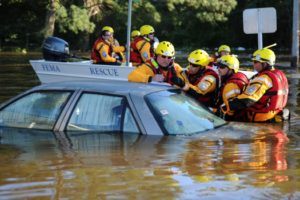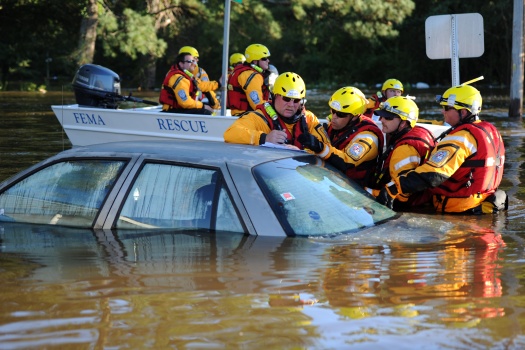In the months since Hurricane Matthew, Dawn Sawyer has watched her 9-year-old, Sam, bite his nails down to “nubs.”
She’s never seen him do that before.
As Sam remembers it, he slept right through the storm. He knows the water was high that night, but he only worried about a swaying tree outside his bedroom window.
Dawn recalls it differently. Sam woke up in the middle of the night when she did. They could hear yelling in their Windsor Woods, Va., neighborhood, and when they looked outside, they saw bobbing flashlights from people trying to wade out of their flooded homes.
The Sawyers stayed inside without power for a day before walking to a friend’s house. When they returned, Dawn noticed Sam seemed nervous.
He doesn’t spend as much time downstairs, where the floor is still concrete and the smell of water damage and mold lingers. And Dawn knows Sam has been waking up in the middle of the night to check on his mom and dad, as he did that a few years ago when she had cancer.
“I felt terrible,” Dawn said. “We couldn’t reassure him that it can’t happen again because we don’t know.”

Six months after Hurricane Matthew swept through the area, destroying homes and upending lives, the Sawyers are one family among hundreds still trying to scrape together some shreds of normalcy.
Many live in one of the hardest-hit areas, Windsor Woods.
About 1,400 properties flooded in the storm, 250 of them in that neighborhood. Residents have criticized the city for its slow and limited response, angry that the rebuilding process has dragged on.
In a recent interview, Deputy City Manager Steve Cover said officials responded as fast as they could but are limited in what they can give homeowners to help. The city, he said, has funneled millions of dollars into recovery efforts by replacing city property, helping displaced residents and committing money to fix drainage problems.
But many people are falling short of what they need to finish all the renovations and get their lives back on track. And many think the city should help them with that.
The Sawyers’ house had flooding on the bottom floor. Dawn and her husband, Chris, are still dealing with the insurance and mortgage paperwork to finish the repairs. The carpet has been ripped up and some of the walls replaced, but the family can’t find a contractor that will work within the requirements of their mortgage company to finish the job.
Sam doesn’t mind much that his house isn’t totally fixed yet. Compared to some of his friends, he said, he was lucky.
Most of his neighbors and friends are back home now. For a few months, the street was eerily empty.
“It was really weird,” he said. “No one else was around. It was pretty much a ghost town.”
Now, kids are playing in the street again next to industrial-sized dumpsters and storage pods.
“I think he’s OK,” Dawn said. But, she added: “He won’t forget it.”
Before Hurricane Matthew, Michelle Michaelian helped organize aid trips to far-flung locales for the Virginia Conference of the United Methodist Church.
When most people think of mission trips to help to rebuild storm-ravaged communities, they probably envision Guatemala or Haiti, or maybe post-Hurricane Katrina Louisiana, she said.
But then devastation came to her doorstep.
“This is home for me. When you’re in this kind of work and it happens here, this is our disaster,” said Michaelian, who had a day job as an office manager at St. Nicholas Greek Orthodox Church.
“Our kids go to school with these kids. We go to the grocery store with these kids. We go to church with these people.”
Before long, she’d swapped her day job for a mission in Hampton Roads, putting in 70-hour weeks to keep a steady stream of Methodist volunteers flowing into the area. They joined the nonprofits and religious charities that rushed to fill the gap once federal aid dried up.
One recent Saturday, a crew from Herndon replaced the insulation under a house on Little Neck Road. The basement and crawlspace had flooded during the storm and the insulation was infused with mold. The family didn’t realize it until the children’s respiratory problems forced multiple trips to urgent care, Michaelian said.
With everything she’d seen of disasters elsewhere, Michaelian saw Matthew coming – not the specific storm, but the scenario.
“It was a matter of time for all of us living here. We got lucky until now,” she said. “We’re already planning for the next one.”
Jakki Santella’s home felt brand-new last October.
The month before, she and her husband finished renovations they had to start because of a sewage backup. They redid their bottom floor like a beach cottage, with bamboo flooring and quartz countertops.
Then the hurricane struck. Water seeped from underneath the floors as neighborhood drains backed up and her street filled with water. The Santellas were out that night, but they knew Windsor Woods often flooded in heavy rain.
When they waded back to their house through waist-high water the next morning, it was clear their newly renovated home was ruined. They could make do in the upstairs of the 1970s-era split-level house, but the first floor was unusable.
With three kids, a full-time job and a full course load in nursing school, Jakki decided to go home despite the damage.
“We were trying to keep life as normal as possible,” she said.
Today the couple are still working on repairs. This time, there is no bamboo – just regular flooring that won’t cost so much to replace, Jakki said.
There’s a maze of paperwork to navigate, between the insurance and mortgage companies and the bank. The couple dipped into their retirement savings and fell behind on their mortgage payments because Jakki had to take so much time off work to make her home livable. And Christmas was more sparse than it has been in past years.
“I just feel so heartbroken,” she said. “You don’t plan for this.”
Jakki tried to get help from the city the week after the storm when a Disaster Recovery Center was set up to help with immediate needs such as food, housing and clothing. While she could live in her house and had clothes, most of her food had gone bad.
But there weren’t many options at the center besides public assistance, and the Santellas don’t qualify. A friend bought them groceries that week.
“The neighbors were the most help,” Jakki said.
Linda Reynolds was due for retirement in January, but after Hurricane Matthew, she has put it off several times.
“Everything has changed in our life,” she said. “I’m not so sure I’m going to be able to retire.”
She and her husband, Curtis, wanted to spend some time in the home they own in West Virginia and go to California to see Curtis’ family. But even casual traveling might be out of the budget now, she said.
Curtis has always fixed things around the house, but this is his biggest project yet. He spends most of his days in their Windsor Woods ranch home ripping up flooring, tearing out walls and cleaning water damage.
The Reynolds have put tens of thousands of dollars into their home. Still, about $50,000 worth of work needs to be done, Linda estimated.
She worries her husband’s work won’t be enough and they’ll be stuck in their home, dealing with flooding when they should be enjoying retirement.
“The biggest thing is that, once we get the house together, is if it’s going to be able to sell,” she said. “Curt and I will survive. If worst comes to worst, we can just lock up the house and go to West Virginia.”
Linda has lived in the home since 1989. She had never seen flooding like Hurricane Matthew brought, but noticed it get worse over the years.
“I think the city dropped the ball a long time ago,” she said. “I want them to do something so this doesn’t happen to our neighborhood again.”
“Welcome to half a house,” David Crawford announced as he walked into his home of 31 years.
With no floors and walls torn down to the studs, the house on Forest Trail in the Bow Creek area looks like it’s being built from scratch. Only one bathroom door still hangs inside, showing how far the flood waters rose – 18 inches.
The demolition has been a family affair, with Crawford tearing out carpeting and drywall with his sons, siblings and in-laws. Since October they’ve filled five dumpsters with trash and three storage units with salvaged materials.
The family lost two cars. Furniture will have to be replaced, including kitchen appliances and the couch where Crawford huddled with his wife, son and dogs to avoid the rising waters. Crawford’s wife’s wedding dress, stored in a chest on the floor, was ruined.
Crawford had flood insurance, and after a month, an insurance adjuster finally arrived from Florida. As he went back and forth with Crawford, the family waited in a house without interior walls or floors.
“Some of those nights that got down to 20 (degrees), with no insulation in the walls, the heat couldn’t keep up,” Crawford said.
This winter, Crawford bought a trailer secondhand just to have a place to eat and sleep while the house was waiting to be overhauled. It’s parked on the front lawn, next to the dumpster.
Contractors have only just started rewiring the electrical system and installing a new fireplace and AC unit. In the kitchen, at a stove that stands alone, Crawford stirred pasta into boiling water and said he hopes the family will be able to move back into the house by the end of April.
“Nobody in their right mind thought it would take this long.”
Was this article valuable?
Here are more articles you may enjoy.


 First Brands Judge Approves Examiner to Probe Fraud Allegations
First Brands Judge Approves Examiner to Probe Fraud Allegations  Tesla, EEOC Plan Talks to Settle Factory Racism Suit
Tesla, EEOC Plan Talks to Settle Factory Racism Suit  Singer’s Elliott Sued by PE Firm in Escalating Fight Over Money
Singer’s Elliott Sued by PE Firm in Escalating Fight Over Money  OpenAI And Microsoft Sued Over Murder-Suicide Blamed on ChatGPT
OpenAI And Microsoft Sued Over Murder-Suicide Blamed on ChatGPT 